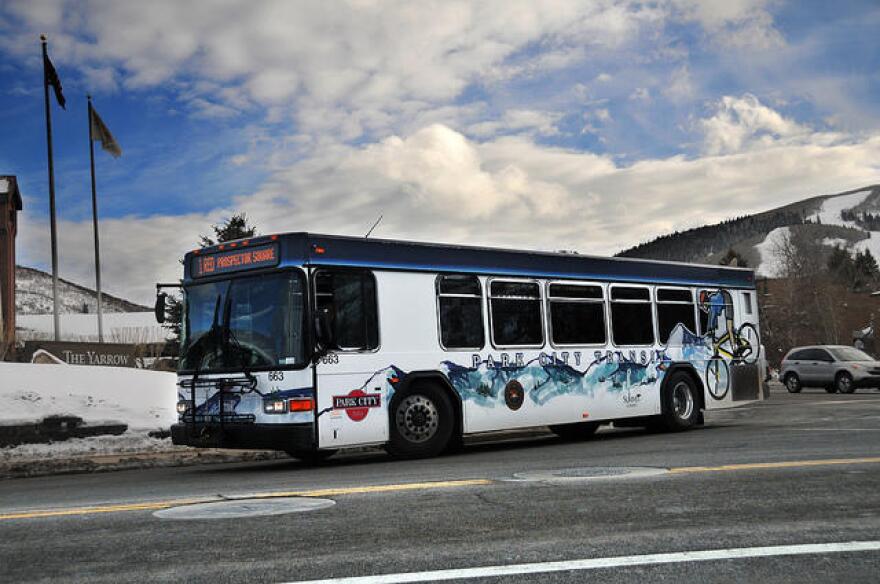Transportation planners for Park City and Summit County have seen ridership figures sink in recent months, and a large portion of the last meeting of the Joint Transportation Advisory Board trying to figure how to plan for the upcoming winter season.
And on Wednesday, the Summit County Council will discuss some further cuts in this year’s budget.
One of those is for the Snyderville Basin Transit District. According to the staff packet, County Transportation Manager Caroline Rodriguez is recommending a nearly 20 percent budget cut.
Meanwhile, at last week’s JTAB meeting, Park City data analyst Robbie Smoot said that ridership in the Park City/Snyderville transit system had decreased from 76% to as much as 81% during the coronavirus outbreak. He said the ridership per hour was quite small, and the cost per rider was high, although they also acknowledge that ridership in the April shoulder season is low anyway.
Scott Burningham, also from Park City, said that by comparison, in the shoulder season of 2019, they saw some 2,000 to 2,500 riders per day. During the summer last year, it climbed closer to 5,000 a day.
He said that in the recent shoulder months, ridership was less than 600 people per day. This summer, it’s been less than 1,400 riders a day.
And concerning the Salt Lake to Park City service, county transportation staffer Jamie Dansie said ridership had declined 92% in April, 84% in May and 72% in June.
She said that UTA and the county have cut two trips in the morning and two in the afternoon, although that is still leaving 8 trips up and down Parleys Canyon per day.
Park City Council Member Steve Joyce said the city has taken some actions that haven’t increased bus ridership.
“Honestly, at least here in town, we kind of exacerbate that a little bit, that we’ve made parking free, not only in China Bridge, but on the street,” Joyce said. “So that just kind of reduces the incentive to take the bus instead of driving, a little bit more, on top of what everybody else is seeing.”
Smoot said he didn’t see much indication that they need to increase service this season.
At the same time, County Councilor Glenn Wright said in a message that the current minimized service could be improved. His colleague Kim Carson read an email from Wright, a Prospector resident who rides the citywide route fairly frequently.
“I rode the citywide route yesterday,” Wright’s message read. “While I fully understand the financial reasons for creating that route out of several other routes, the route is worthless for anyone other than someone who has no other means of transit. It’s a long, circuitous route with 30-minute frequency. There were few passengers on it, on a day with a fair amount of visitors in town.”
Wright added that the citywide route is perhaps appropriate for the shoulder seasons, but not for the summer peak.
Steve Joyce also said the bus system could be impacted by the recent news that the Trump Administration is restricting foreign worker visas, including the J-1 visas that are a source of employees for the ski resorts. Joyce said those foreign seasonal workers are also a major contingent of riders on the buses.
He said the resorts may have to hire employees driving their cars from Salt Lake or Heber.
Councilor Tim Henney said the real wild card is if visitors next winter are willing to climb onto crowded buses with their skis.
“I do not believe that the people that would normally be riding transit feel safe and comfortable to ride transit,” Henney said. “And I don’t know how we’re going to suss that aspect out and make a trigger point on when we do dial up the service. Because I know we’ve talked about dialing up the service, and that we had the ability to do that. And there was even an assumption and maybe an expectation that we were going to dial up the service to what would be off-season in our peak season. Well, here we are in peak season. So, is that something we should be considering, or to Robbie’s point, the data, the ridership data, isn’t showing demand. But to Glenn’s point, if the service was there, would people opt for transit.”
The city staffers said they can provide different options of how much they can cut compared to last year’s transit budget. One option suggested a 6% decrease. But Henney said they will likely have to cut deeper than that.
“Look, we can reduce, versus last year’s budget 6% by doing these various things,” Henney said. “And it’s all about lunches and overtime. If we want to go deeper, it’s going to affect routes. It’s going to affect frequency. It’s going to affect scheduling. It’s going to affect when we begin, when we end. So I think that’s the message. It’s not a message of ‘We’re projecting 6% decline in revenues next year. And we can meet that with this.’ I think that’s the first cut.”
One sign of hope is that aid from the federal CARES Act will be allocated by UDOT. But when that funding comes, and how much, isn’t known.
Rodriguez recommended they implement cutbacks, and they can then restore services if the CARES money comes through.
The city and county officials generally agreed they have to make some decisions by the end of September, and directed their staffers to come back with options.
Finally, County Manager Tom Fisher talked about the dilemma he wants to avoid.
“There’s always the question what we can afford," Fisher said. "And the CARES Act money comes into that. But I really hate to have a lot of service out there too that’s not carrying anybody. And that’s the wild card.”





